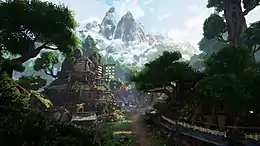Kena: Bridge of Spirits
Kena: Bridge of Spirits is an upcoming action-adventure game developed and published by Ember Lab. The story follows Kena, a young spirit guide who uses her magical abilities to help deceased people move from the physical to the spirit world. The game is presented through a third-person perspective. The player uses Kena's staff for attacking enemies, and her pulse ability for defending against attacks. They are tasked with collecting small spirit companions known as the Rot, who help to complete tasks and battle against enemies.
| Kena: Bridge of Spirits | |
|---|---|
 | |
| Developer(s) | Ember Lab |
| Publisher(s) | Ember Lab |
| Composer(s) | Jason Gallaty |
| Engine | Unreal Engine 4 |
| Platform(s) | |
| Release | March 2021 |
| Genre(s) | Action-adventure |
| Mode(s) | Single-player |
The game's development is led by brothers Mike and Josh Grier, founders of Ember Lab. Having spent several years creating commercials and branded applications, the development team shifted to creating an original video game. They partnered with Sony Interactive Entertainment for a console-exclusive deal, and grew the team to 15 core employees. The game's art is created in collaboration with Vietnamese animation studio Sparx, and its fictional world is inspired by Eastern locations such as Japan and Bali. The original score is composed by Jason Gallaty, who collaborated with Balinese ensemble group Gamelan Çudamani to create respectful gamelan music.
Announced in June 2020, Kena: Bridge of Spirits is scheduled for release in March 2021 for Microsoft Windows, PlayStation 4, and PlayStation 5.
Gameplay
Kena: Bridge of Spirits is an action-adventure game played from a third-person perspective.[1] The player controls Kena, a young spirit guide with magical abilities.[2] In combat, the player uses Kena's staff for light, heavy, and charged attacks. An upgrade transforms the staff into a bow. When defending against enemies, the player can activate Kena's pulse ability, which acts as a shield and has a health meter that depletes when attacked;[3] it also serves to provide clues and activate objects.[4] The player is tasked with collecting small spirit companions known as the Rot.[2] They can be directed to complete tasks, such as moving objects, taking certain shapes, or distracting enemies. The player must damage enemies before the Rot builds enough courage to join battles. The Rot can be customized with different hats.[3] The game utilizes the DualSense controller's haptic feedback for features such as Kena's Spirit Bow.[2]
Synopsis
Kena: Bridge of Spirits is set in a fictional location which is not Kena's place of origin.[3] The main village, which acts as the game's hub world, is abandoned at the beginning of the game, having been struck by a tragedy hundreds of years earlier. Throughout the game, Kena restores the area to an improved state.[4] In the game's lore, deceased people can remain between the physical and spirit worlds if they are traumatized or feel unfinished. As a spirit guide, Kena tries to understand their difficulties and help them to move on.[3] Kena has a scar from her hand to her shoulder, which represents a traumatic experience with her father that will be explored in the game.[5] Other characters include Saiya and Beni, two young children whose teenage brother, Taro, is a restless spirit who Kena helps.[4]
Development
Kena: Bridge of Spirits is developed by Ember Lab, a 14-person independent studio based in Los Angeles. Founded in 2009 by brothers Mike and Josh Grier, the studio has worked on several animated commercials and branded game applications, and in 2016 released a viral short film based on The Legend of Zelda: Majora's Mask titled Terrible Fate.[2] The development team felt that creating a video game was the "natural next step".[6] Along with a small team, Mike used his experience with programming to create a prototype over several years, before employing staff with more extensive development experience.[4] Once the prototype was complete, the team began pitching to potential publishing partners with assistance from industry veteran Tina Kowalewski. They found that several publishers were familiar with their work on Terrible Fate. Around eight months after their first round of pitching, Ember Lab signed a console-exclusive deal with Sony Interactive Entertainment. The team grew to 15 core employees, with additional help outsourced to other studios.[4]
For the game's art, Ember Lab partnered with Vietnamese animation studio Sparx. The team visited the studio in Vietnam early in development to ensure a smooth process. Lead environment artist Julian Vermeulen worked with both studios.[4] An early prototype used the Unity game engine, but later shifted to Unreal Engine 4.[3] The majority of development took place on PlayStation 4;[7] the team was unsure if they would be provided a development kit for the PlayStation 5, but Sony eventually approved.[4] The team wanted to make a "rich experience" that could be completed in a weekend.[4] The game's fictional world is inspired by several Eastern locations, including Japan and Bali.[3]
Earlier prototypes of the game focused on the Rot as antagonists, and did not feature Kena. When the team created Kena, she was initially younger—around seven or eight years old—but they felt that the story and themes required a more experienced and mature protagonist. She originally lacked many powers and relied more heavily on the Rot to complete tasks, which Mike Grier compared to the 2009 game A Boy and His Blob. After exploring more concepts, the team made Kena strong on her own, but more powerful when teamed with the Rot. Lead character designer Vic Kun designed Kena's appearance to match the world while also standing out. At one point, Kena had a long cape, but its animation was deemed too distracting and replaced with a shawl. Kun intended her clothes to feel asymmetrical, handmade, and practical. The game's characters were hand-animated using keyframe animation to add more detailed personality.[8] The symbols throughout the game are inspired by Japanese and South East Asian cultures.[5]
The game's original score is composed by Jason Gallaty. Gallaty was listening to the music of Balinese ensemble group Gamelan Çudamani for inspiration, and reached out to seek a collaboration, wanting to remain respectful to the culture. Gamelan Çudamani's associate director and lead singer Emiko Saraswati Susilo was initially hesitant, not wanting traditional gamelan music to be featured in a video game, but agreed to collaborate after speaking to the team and resonating with the game's themes. Gallaty and Mike Grier traveled to Bali to record with the group. Gamelan Çudamani's founding director, Dewa Putu Berata, created original compositions based on footage and descriptions of the game. When Gallaty presented samples of sacred music, Berata would inform him if it was inappropriate, and instead create a new composition with a similar feeling.[9] The game features music with vocals from Susilo, who also voices Kena.[3][8] Despite being influenced by the films of Disney, the team avoided in-game musical performances to keep the game more grounded.[8]
The game was announced on June 11, 2020, at PlayStation's Future of Gaming event, with a scheduled for release in late 2020 for Microsoft Windows, PlayStation 4, and PlayStation 5.[10][11] It is a timed console exclusive,[12] and will release on Windows through the Epic Games Store.[3] Players who purchase the PlayStation 4 version will be able to upgrade for free to the PlayStation 5 version.[13] In September 2020, Ember Lab delayed the game to Q1 2021, citing development delays as a result of working from home during the COVID-19 pandemic.[14] The game is currently set for release in March 2021.[8] In October 2020, former designer Brandon Popovich claimed that Ember Lab did not fully compensate him for his work on the game and failed to honour promises made regarding equity and a promotion; an anonymous source issued similar claims, accusing the company of unpaid overtime and unfulfilled promises of a full-time position. Ember Lab responded, claiming that it had records of all invoices being paid and denying any promises of equity or promotions.[15]
References
- Kato, Matthew (June 11, 2020). "Enter The Enchanted World Of PS5's Kena: Bridge Of The Spirits". Game Informer. GameStop. Archived from the original on June 14, 2020. Retrieved June 14, 2020.
- Takahashi, Dean (June 11, 2020). "Kena: Bridge of Spirits is a story of redemption with cute characters on the PS5". VentureBeat. Archived from the original on June 14, 2020. Retrieved June 14, 2020.
- Cork, Jeff (September 8, 2020). "20 Questions (And Answers) About Kena: Bridge Of Spirits". Game Informer. GameStop. Archived from the original on September 8, 2020. Retrieved September 12, 2020.
- Cork, Jeff (September 9, 2020). "Crossing Over". Game Informer. No. 329. GameStop.
- Wallace, Kimberley (September 12, 2020). "Designing Kena: Bridge of Spirits' Fierce And Compassionate Protagonist". Game Informer. GameStop. Archived from the original on September 12, 2020. Retrieved September 12, 2020.
- Grier, Josh (June 11, 2020). "Kena: Bridge of Spirits from indie studio Ember Lab announced for PS5". PlayStation Blog. Sony Interactive Entertainment. Archived from the original on June 12, 2020. Retrieved June 14, 2020.
- Cork, Jeff (September 8, 2020). "What Does The PS5 Bring To Kena: Bridge Of Spirits?". Game Informer. GameStop. Archived from the original on September 8, 2020. Retrieved September 12, 2020.
- "Spirited away". PlayStation Official Magazine – UK. No. 183. Future plc. January 2021. pp. 12–13.
- Cork, Jeff (September 17, 2020). "Behind The Scenes Of Kena: Bridge Of Spirit's Harmonious Collaboration". Game Informer. GameStop. Archived from the original on September 19, 2020. Retrieved September 19, 2020.
- Kim, Matt (June 12, 2020). "Kena: Bridge of Spirits Announced for PS5". IGN. Ziff Davis. Archived from the original on June 14, 2020. Retrieved June 14, 2020.
- Chalk, Andy (June 11, 2020). "Kena: Bridge of Spirits is coming to PC later this year". PC Gamer. Future plc. Archived from the original on June 14, 2020. Retrieved June 14, 2020.
- Suddi, Aran (June 11, 2020). "Kena: Bridge of Spirits announced and will be a timed PS5 console exclusive". The Sixth Axis. Oscar Mike Media Ltd. Archived from the original on June 14, 2020. Retrieved June 14, 2020.
- Devore, Jordan (August 13, 2020). "PS4 players can upgrade Kena: Bridge of Spirits to the PS5 version for free". Destructoid. Enthusiast Gaming. Archived from the original on August 15, 2020. Retrieved August 15, 2020.
- Dornbush, Jonathon (September 12, 2020). "Kena: Bridge of Spirits Delayed to Q1 2021". IGN. Ziff Davis. Archived from the original on September 11, 2020. Retrieved September 12, 2020.
- Valentine, Rebekah (October 5, 2020). "Designer accuses Ember Labs of underpayment, unfulfilled promises". Gamesindustry.biz. Gamer Network. Archived from the original on October 3, 2020. Retrieved October 6, 2020.
